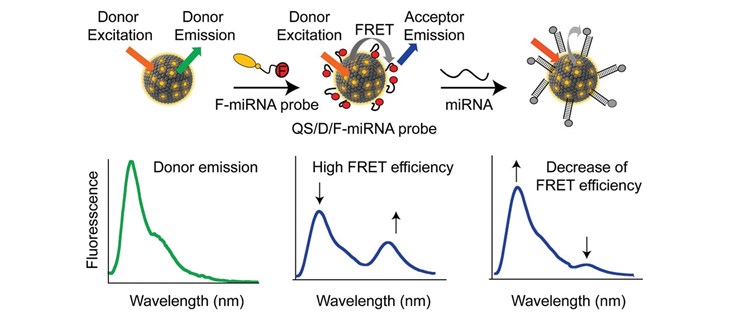New fluorescent nanovesicles for intracellular biomarker detection
A new work by researchers from the CIBER-BBN at the Barcelona Institute of Materials Science ICMAB-CSIC, together with a team from the University of Rome Tor Vergata, presents new nanovesicles capable of crossing biological barriers such as cell membranes, maintaining their sensory capacity, making them attractive probes for intracellular biomarker detection.
“The development of probes capable of detecting the biological environment and signaling the presence of a specific target molecule is a challenge with relevance in a variety of biomedical applications, from drug administration to diagnostic tools” says Mariana Köber, one of those responsible of the investigation together with Nora Ventosa and Alessandro Porchetta from the University of Rome Tor Vergata.
In this work, which has been published in Advanced Functional Materials, the design of functionalized fluorescent nanovesicles with biomimetic DNA capable of translating their binding with a target molecule into an optical output is presented, through a change in the transfer of resonance energy. Förster (FRET) and fluorescent emission. These Quatsomes (QS) nanovesicles are an emerging class of highly stable small unilamellar vesicles ≈50–100 nm in diameter, formed by the self-assembly of ionic surfactants and sterols in aqueous media. Their high stability, also in body fluids, unilaminarity and particle-to-particle homogeneity make them an attractive soft material for detection applications. “QS nanovesicles are loaded with fluorescent waves based on amphiphilic nucleic acids to produce programmable FRET active nanovesicles that function as highly sensitive signal transducers,” she explains.
The CIBER-BBN researchers have participated in the characterization of the photophysical properties of these nanovesicles and the highly selective detection of clinically relevant microRNAs with sensitivity in the nanomolar range has been demonstrated. This production of nanovesicles and their physicochemical characterization has been carried out thanks to the services of ICTS NANBIOSIS, through its unit 6 of Biomaterials Processing and Nanostructuring at the ICMAB-CSIC.
According to the authors, the proposed strategy could easily be adapted to the detection of different biomarkers: “we hope to achieve a bioimaging platform for the detection of a wide range of nucleic acids and other clinically relevant molecules in body fluids or directly in cells, thanks to the ability of Quatsomes for intracellular delivery. “
- Figure: Schematic representation of the DNA-grafted QS nanovesicles. Adv Funct Materials, Volume: 31, Issue: 46, First published: 11 August 2021, DOI: (10.1002 / adfm.202103511)
Article of reference
Marianna Rossetti, Lorenzo Stella, Judit Morlà-Folch, Sara Bobone, Ariadna Boloix, Lorena Baranda, Danila Moscone, Mònica Roldán, Jaume Veciana, Miguel F. Segura, Mariana Köber… Engineering DNA-Grafted Quatsomes as Stable Nucleic Acid-Responsive Fluorescent Nanovesicles . https://doi.org/10.1002/adfm.202103511









